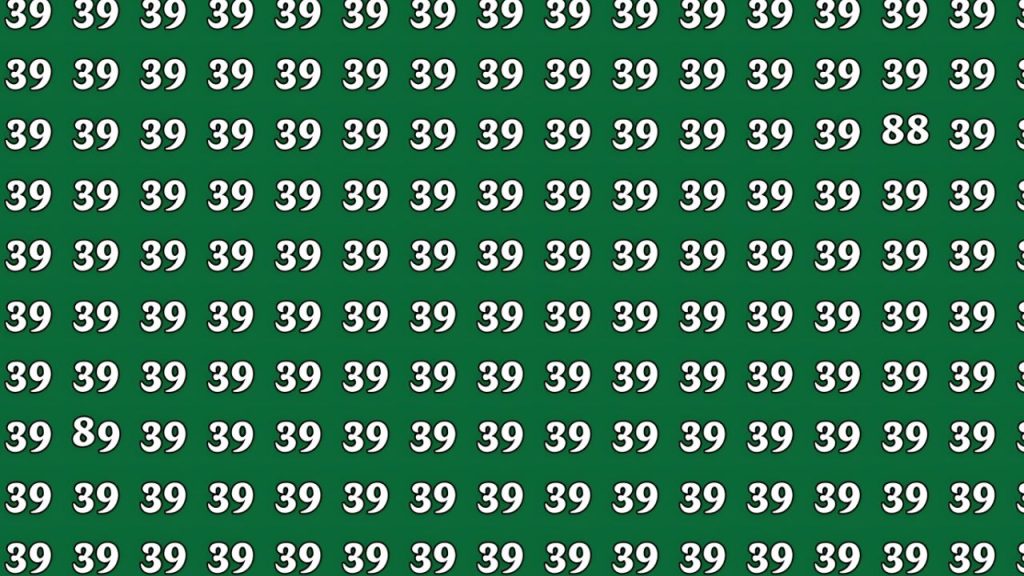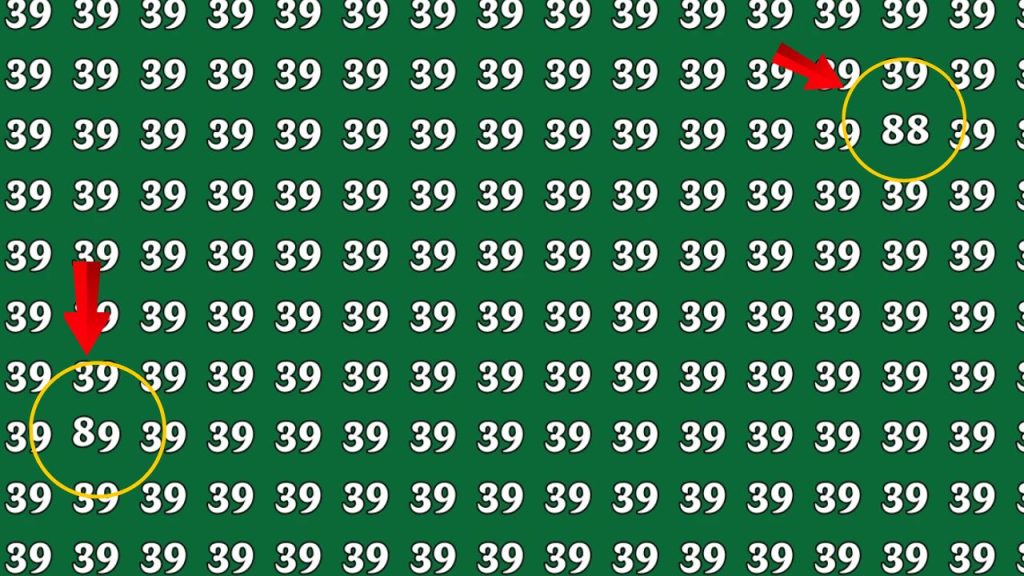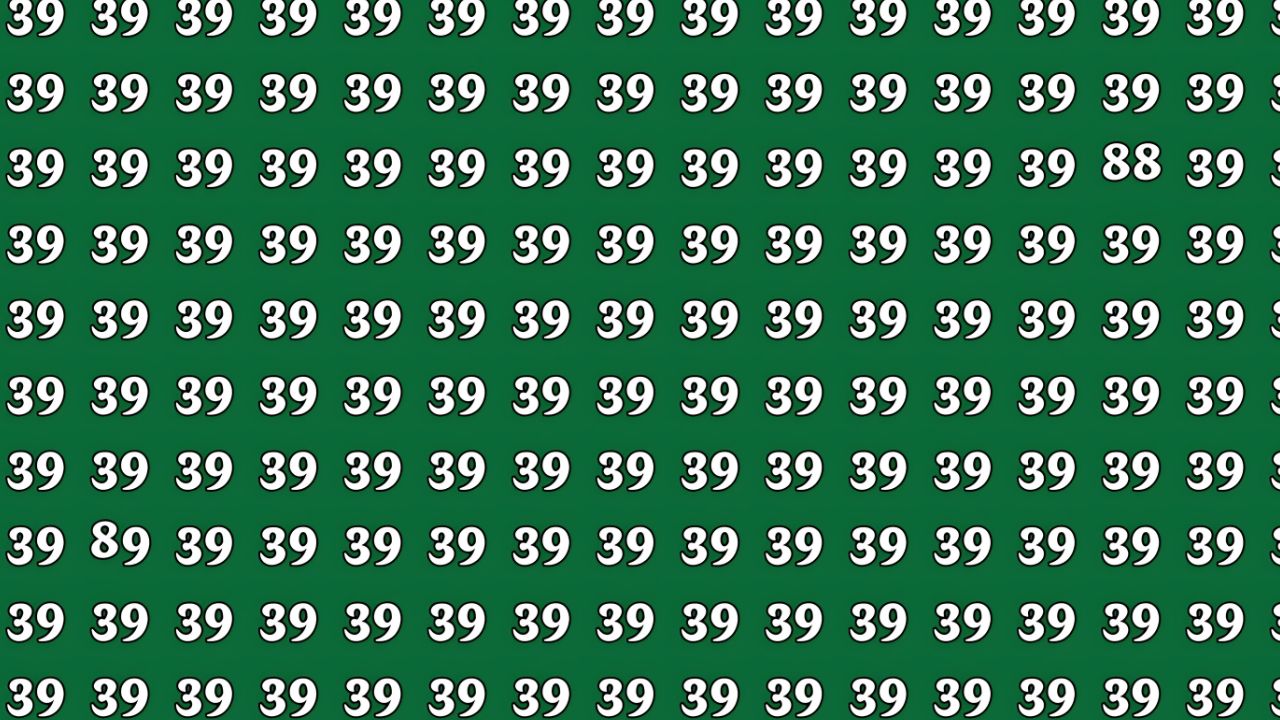The human brain loves a good challenge, especially when it comes to visual puzzles. Today’s optical illusion will test your observation skills like never before.
Your mission seems simple enough at first glance. Among hundreds of the number 39, you must locate the hidden 88 and 89 within just seven seconds.
What Makes This Challenge So Tricky?
Our brains process visual information faster than we can consciously think. However, when similar patterns flood our vision, everything becomes much more complicated.
The numbers 39, 88, and 89 share surprising visual similarities. Your eyes must distinguish between curved and straight lines while racing against the clock.
The Psychology Behind Number Recognition
Pattern recognition forms the foundation of how we read numbers daily. When we see familiar shapes, our brain takes helpful shortcuts to process information quickly.
These mental shortcuts can work against us in optical illusions. Similar-looking digits create confusion that slows down our natural recognition process significantly.

How Your Brain Processes This Visual Challenge
The visual cortex in your brain handles all incoming sight information. It breaks down images into basic components like lines, curves, and angles.
When faced with repetitive patterns, this system can become overwhelmed. Cognitive overload happens when too much similar information floods your processing centers.
Why Seven Seconds Creates Pressure
Time pressure activates your brain’s fight-or-flight response in subtle ways. This stress can either sharpen your focus or scatter your attention completely.
Some people perform better under pressure while others need more time. Individual differences in processing speed affect how quickly you can solve these puzzles.
Tips and Strategies for Success
Systematic scanning works better than random searching for most people. Try dividing the image into sections and examining each area methodically.
Look for visual anomalies rather than trying to read each number individually. The different shapes should stand out if you relax your focus slightly.
The Zone-Out Technique
Many puzzle experts recommend unfocusing your eyes slightly when searching. This technique helps patterns pop out from busy backgrounds more easily.
Think of it like those magic eye pictures from the 1990s. Sometimes stepping back mentally helps you see what’s hiding in plain sight.
Grid Method Approach
Imagine invisible grid lines dividing the puzzle into smaller squares. Systematically check each square from left to right, top to bottom.
This methodical approach prevents you from missing sections or repeatedly checking the same areas. Organization beats chaos every single time.
The Science of Optical Illusions
Optical illusions exploit the gaps between what we see and what actually exists. Our brain fills in missing information based on past experiences and expectations.
Gestalt psychology explains how we perceive whole patterns rather than individual parts. This natural tendency can hide obvious details right before our eyes.
How Your Eyes Actually Work
Your retina contains millions of light-sensitive cells called rods and cones. These cells convert light into electrical signals that travel to your brain.
Blind spots exist where your optic nerve connects to your retina. Your brain cleverly fills in these gaps without you noticing the missing information.
Processing Speed Variations
Individual differences in visual processing create varying success rates with these challenges. Age, experience, and even caffeine intake can affect your performance.
Practice definitely improves your ability to spot hidden elements quickly. Regular puzzle solving strengthens the neural pathways involved in pattern recognition.
Benefits of Regular Puzzle Solving
Brain training through visual puzzles can improve cognitive function over time. These exercises work out your attention and concentration muscles effectively.
Memory improvement often results from regular puzzle practice. The mental effort required strengthens connections between different brain regions naturally.
Stress Relief Through Focus
Mindful concentration on puzzles provides excellent stress relief for many people. The focused attention required pushes worrying thoughts into the background temporarily.
Flow states can develop when you become completely absorbed in challenging puzzles. This mental state promotes relaxation and psychological well-being significantly.
Social Connection Opportunities
Sharing puzzles with friends and family creates fun bonding experiences. Comparing results and discussing strategies builds social connections through shared challenges.
Competition elements add excitement when solving puzzles with others. Friendly rivalry motivates people to improve their observation skills continuously.
Common Mistakes People Make
Rushing through the puzzle often leads to missing obvious answers. Anxiety about the time limit can actually slow down your natural recognition abilities.
Overthinking the challenge creates unnecessary complications in your mind. Sometimes the most obvious solution is exactly what you’re looking for.
Pattern Tunnel Vision
Focusing too narrowly on perfect number shapes can blind you to variations. The hidden numbers might appear slightly distorted or rotated from standard positions.
Flexibility in your search approach increases success rates dramatically. Open-minded searching beats rigid expectations every single time.
Eye Strain Issues
Staring intensely without blinking can cause eye fatigue quickly. Regular blinking keeps your eyes moist and your vision clear throughout the challenge.
Proper lighting makes a significant difference in puzzle-solving success. Adequate illumination reduces eye strain and improves detail recognition substantially.
The Hidden Numbers Revealed
Spoiler alert for those still searching! The 88 typically appears in the upper middle section of most versions.
The 89 usually hides in the lower right quadrant, though positions vary. Different puzzle versions place these numbers in various locations strategically.
Why These Locations Work
Strategic placement in less obvious areas increases difficulty levels appropriately. Corner positions and center locations get checked first by most people.
Edge areas often receive less attention during quick searches. Puzzle creators understand these natural scanning patterns and use them cleverly.
Creating Your Own Number Challenges
Making puzzles for friends and family can be incredibly entertaining. Simple graphics programs allow you to create custom visual challenges easily.
Vary the difficulty by changing background patterns, colors, or target numbers. Creative variations keep these games fresh and exciting for everyone.
Digital vs Physical Puzzles
Screen-based puzzles offer convenience and easy sharing capabilities. However, printed versions reduce eye strain for extended puzzle sessions.
Lighting conditions affect digital puzzles more than physical ones. Monitor brightness and room lighting should be balanced for optimal viewing comfort.
Age-Appropriate Variations
Children often excel at these challenges due to their natural curiosity and flexible thinking patterns. Simpler versionswork better for younger puzzle solvers.
Senior citizens may need larger text and higher contrast for comfortable viewing. Accessibility considerations make puzzles enjoyable for everyone regardless of age.
The Competitive Puzzle Scene
Speed puzzle competitions exist worldwide for serious visual challenge enthusiasts. Tournament formats test various cognitive abilities under pressure situations.
Online communities share new puzzles and compete for fastest solution times. Social media has created global networks of puzzle enthusiasts.
Record-Breaking Performances
World records exist for various types of visual puzzle solving speeds. Professional puzzlers train daily to maintain their competitive edge consistently.
Training regimens include eye exercises, concentration practice, and pattern memorization techniques. Dedicationand consistent practice separate champions from casual players.
Technology and Future Puzzles
Augmented reality opens new possibilities for interactive visual challenges. 3D puzzles and motion-based challenges represent the cutting edge of this entertainment.
Artificial intelligence creates increasingly sophisticated puzzle algorithms. Machine learning helps generate personalized difficulty levels for individual users automatically.
Educational Applications
Teachers use visual puzzles to improve student attention and focus skills. Classroom applications make learning more engaging and interactive naturally.
Therapeutic uses help stroke patients rebuild visual processing abilities. Medical applications prove these games offer genuine cognitive benefits beyond entertainment.

Frequently Asked Questions
How can I improve my puzzle-solving speed? Practice regularly and try the systematic grid method for better results.
Why do some people solve these faster than others? Individual differences in visual processing speed and experience levels vary greatly.
Are there tricks to finding hidden numbers quickly? Unfocus your eyes slightly and look for pattern disruptions rather than perfect shapes.
Can these puzzles actually improve brain function? Yes, regular practice can enhance attention, concentration, and pattern recognition skills.
What if I can’t find the numbers in seven seconds? Take your time! The seven-second challenge is just for fun, not a requirement.
Do age and eyesight affect puzzle performance? Yes, both factors can influence speed, but practice helps overcome many limitations.
Are digital or printed puzzles better for your eyes? Printed versions typically cause less eye strain during extended solving sessions.
Can children do these puzzles safely? Absolutely! Kids often excel at visual challenges due to their flexible thinking patterns.
How often should I practice these puzzles? A few minutes daily provides good brain exercise without causing fatigue.
Do these puzzles help with real-world observation skills? Yes, improved pattern recognition transfers to many daily activities and tasks.
The Joy of Visual Discovery
Visual puzzles like this 88 and 89 challenge offer wonderful entertainment while exercising your brain. Whether you solve it in seven seconds or seven minutes, the experience provides valuable mental stimulation.
Regular practice with these challenges can genuinely improve your observation skills and cognitive flexibility. The key lies in enjoying the process rather than obsessing over perfect performance every time.
